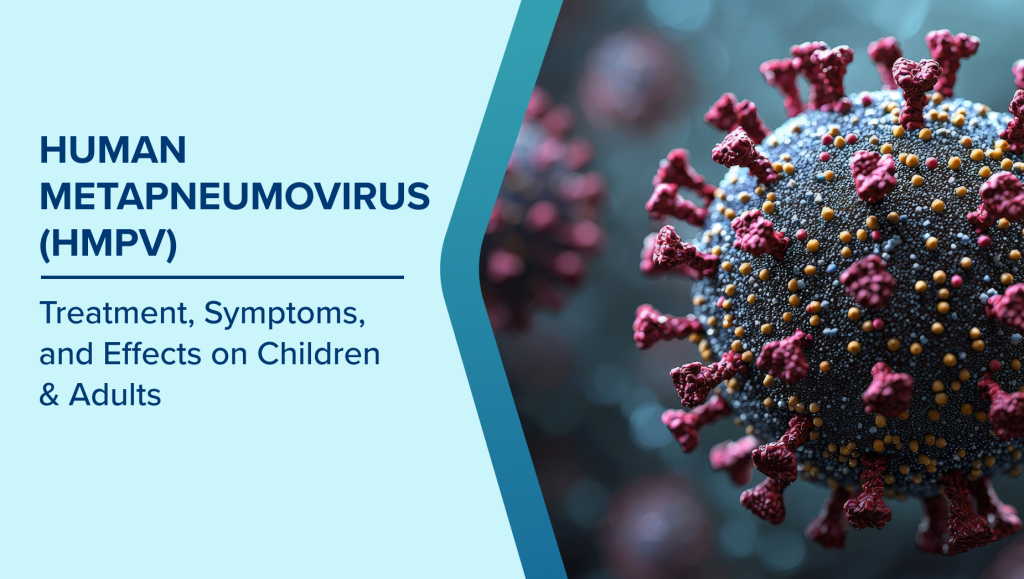Table of Contents
Two Viruses That Affect Our Health
Over the past few years, people around the world have become familiar with COVID-19, a virus that caused a global pandemic. At the same time, there’s another virus, Human Metapneumovirus (HMPV), which also causes respiratory illnesses. Both viruses can make people sick, especially those with weaker immune systems, but they are not the same.
Understanding the similarities and differences between these two viruses can help us take the right steps to protect ourselves and others. This blog will explain what HMPV and COVID-19 are, how they are alike, and how they differ.
What is HMPV?

HMPV, short for Human Metapneumovirus, is a respiratory virus that mainly affects the lungs and airways. It was discovered in 2001 and is common during the winter and spring months.
Key Facts About HMPV:
- Who It Affects:
It can infect people of all ages, but it’s most dangerous for babies, older adults, and people with weakened immune systems. - Symptoms:
Symptoms of HMPV include coughing, runny nose, sore throat, fever, and shortness of breath. Severe cases can lead to bronchitis or pneumonia. - How It Spreads:
Like many respiratory viruses, HMPV spreads through droplets when an infected person coughs or sneezes. It can also spread by touching contaminated surfaces.
What is COVID-19?
COVID-19 is caused by the SARS-CoV-2 virus, a type of coronavirus. It became widely known in 2020 when it led to a global pandemic.
Key Facts About COVID-19:
- Who It Affects:
COVID-19 can infect anyone, but it is particularly severe in older adults, those with chronic illnesses, and people with weakened immune systems. - Symptoms:
COVID-19 symptoms include fever, cough, difficulty breathing, loss of taste or smell, fatigue, and muscle aches. Severe cases can result in pneumonia, organ failure, or even death. - How It Spreads:
COVID-19 spreads through respiratory droplets, close contact, and sometimes through airborne particles in crowded spaces.
Similarities Between HMPV and COVID-19
Both HMPV and COVID-19 are respiratory viruses, which means they primarily affect the lungs and airways. Here’s what they have in common:
1. Spread Through Droplets
Both viruses spread through tiny droplets when an infected person sneezes, coughs, or talks. Touching contaminated surfaces and then touching your face can also spread the infection.
2. Symptoms Overlap
Symptoms like coughing, fever, and shortness of breath are common in both illnesses, making it difficult to tell them apart without specific tests.
3. Risk Groups
Both viruses are more dangerous for:
- Older adults
- Infants and young children
- People with weakened immune systems or chronic health conditions
4. Seasonal Patterns
Both HMPV and COVID-19 cases often rise during colder months when people spend more time indoors, increasing the chances of spreading viruses.
Differences Between HMPV and COVID-19
While these viruses share similarities, there are important differences:
1. Virus Type
- HMPV: A member of the Paramyxoviridae family, related to respiratory syncytial virus (RSV).
- COVID-19: Caused by a coronavirus, which is a different family of viruses.
2. Severity
- HMPV: Generally causes mild to moderate respiratory illness, though severe cases can occur.
- COVID-19: Has caused a global pandemic with a much higher rate of severe illness and death.
3. Symptoms
- HMPV: Primarily affects the respiratory system. It does not usually cause loss of taste or smell, which is common in COVID-19.
- COVID-19: Can affect multiple organs, with unique symptoms like loss of taste or smell and long-term complications in some patients.
4. Vaccines and Treatments
- HMPV: There is no vaccine or specific antiviral treatment for HMPV. Treatment focuses on relieving symptoms.
- COVID-19: Multiple vaccines are available, and antiviral treatments like Paxlovid can help manage the infection.
How to Stay Safe from Both Viruses
Regardless of the virus, the steps to protect yourself and others are similar:
1. Wash Your Hands
Regularly washing your hands with soap and water is one of the best ways to prevent the spread of germs.
2. Wear Masks When Necessary
Masks can help reduce the spread of respiratory droplets, especially in crowded or high-risk settings.
3. Avoid Touching Your Face
Viruses can enter your body through your eyes, nose, or mouth, so try to keep your hands away from your face.
4. Keep Surfaces Clean
Disinfect surfaces that are frequently touched, such as door handles, phones, and tables.
5. Stay Home When Sick
If you’re feeling unwell, stay home to avoid spreading the illness to others.
6. Get Vaccinated
While there’s no vaccine for HMPV, staying up-to-date on vaccines for other respiratory illnesses like flu and COVID-19 can protect you and your loved ones.
Why Understanding These Viruses Matters
Learning about HMPV and COVID-19 helps us take the right precautions and stay prepared. Both viruses remind us how important it is to follow good hygiene practices and stay informed about emerging health threats.
Conclusion: Awareness is Key to Protection
HMPV and COVID-19 may share some similarities, but they are different viruses with unique characteristics. By understanding how they spread and who they affect, we can take steps to protect ourselves and those around us.
As scientists continue to learn more about these viruses, staying informed and practicing good hygiene will remain our best defense. Remember, small actions like washing your hands and staying home when sick can make a big difference in keeping everyone safe.